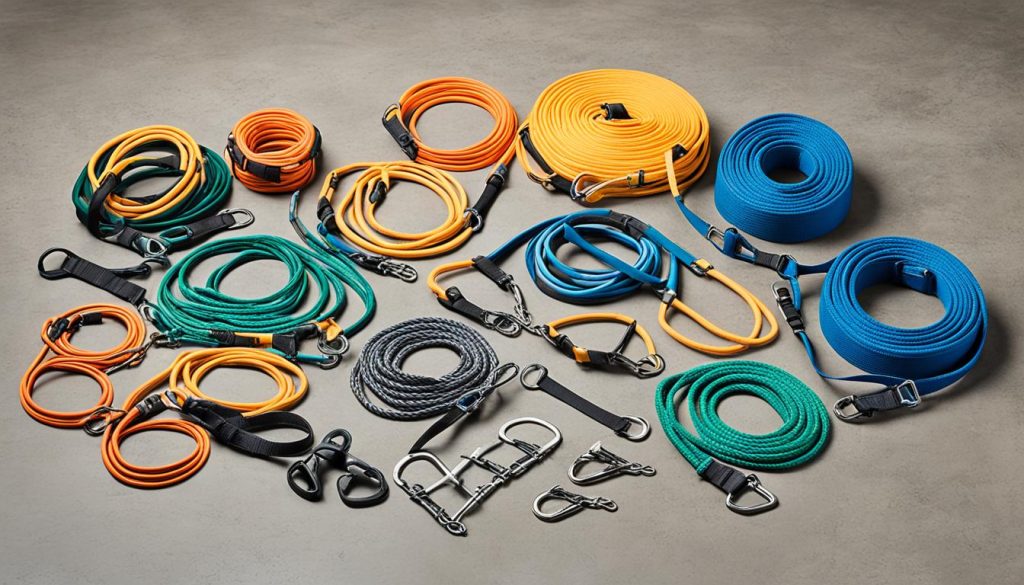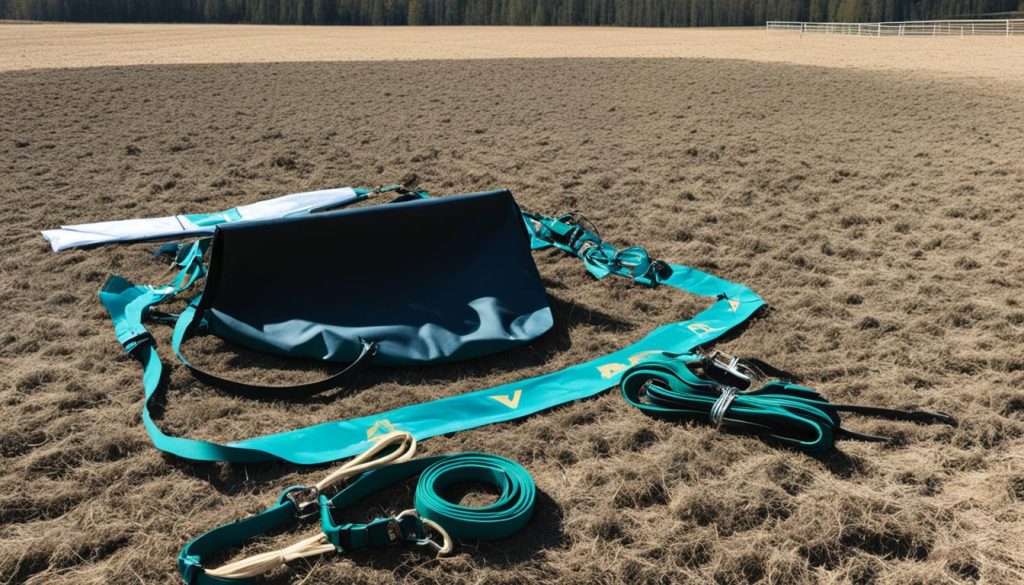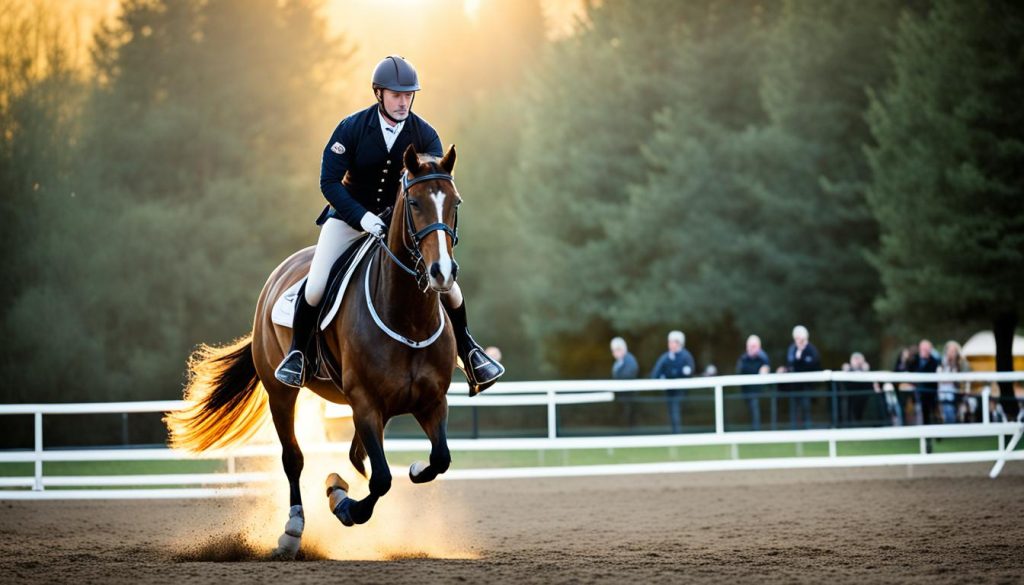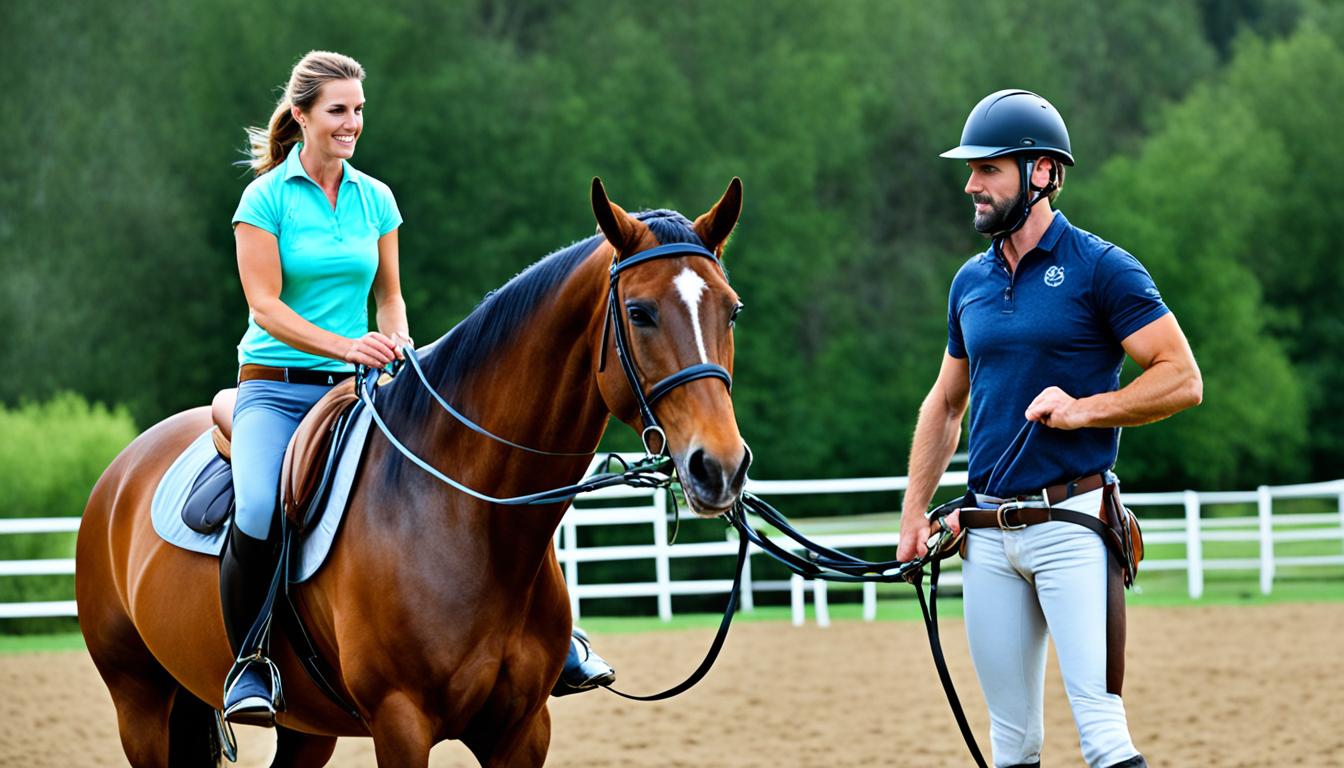Did you know that effective groundwork training can lead to a better bond with your horse and improve their overall behavior?
Groundwork exercises are an essential part of horse training techniques, helping to establish trust, respect, and clear communication between you and your equine partner. Whether you are a beginner or an experienced rider, incorporating equine groundwork exercises can significantly enhance your horse’s training and performance.
Key Takeaways:
- Groundwork exercises form the foundation of effective horse training.
- Working safely with horses on the ground is crucial for a successful training session.
- Leading exercises establish trust and respect between you and your horse.
- Desensitization exercises help your horse overcome fears and become more confident.
- Lunging is an excellent exercise for building trust, balance, and rhythm.
Working Safely with Horses on the Ground
When it comes to working with horses on the ground, safety should always be your top priority. By following proper guidelines and using the right horse groundwork equipment, you can ensure a safe and productive training session. Here are some essential tips to keep in mind:
1. Be Aware of Your Horse’s Body Language
Understanding your horse’s body language is crucial for assessing their mood, stress levels, and potential reactions. By observing their ears, eyes, tail, and overall posture, you can anticipate any signs of discomfort or agitation. This awareness allows you to respond appropriately and prevent accidents during groundwork training.
2. Use Proper Horse Groundwork Equipment
Investing in quality horse groundwork equipment is essential for maintaining control and ensuring your safety. A rope halter and lead rope are excellent tools for effective communication and gentle guidance. The rope halter provides better pressure distribution, while the lead rope allows you to maintain a safe distance from your horse.

3. Wear Appropriate Footwear
Wearing sturdy and closed-toe footwear is crucial for your safety while working with horses on the ground. This type of footwear provides protection against accidental kicks or stepped-on toes. It is recommended to wear boots or shoes with a low heel to prevent your foot from sliding through the stirrup.
4. Designate a Training Area Free from Hazards
Before starting your groundwork training, ensure that you have a designated area that is free from potential hazards. Remove any obstacles such as rocks, tools, or debris that may pose a trip or injury risk. A clear and safe training space allows you and your horse to focus on the training exercises without distractions.
5. Start with Simple Exercises
When beginning your groundwork training program, it is advisable to start with simple exercises. This allows your horse to become familiar with the training process and build confidence in their interactions with you. As your horse progresses and becomes more comfortable, you can gradually introduce more advanced exercises.
Remember, groundwork training is a journey that takes time and patience. Each horse is unique, so progress may vary. Stay consistent, be mindful of safety, and enjoy the process of building a strong bond with your equine partner.
Your Groundwork Training Program
Developing a comprehensive groundwork training program can help you structure your training sessions effectively. It allows you to set specific goals, track your progress, and ensure that you cover all essential aspects of groundwork training. Here is a sample template to guide you:
| Training Activity | Description | Duration |
|---|---|---|
| Leading | Practice leading your horse calmly and confidently using body language and cues. | 15 minutes |
| Desensitization | Expose your horse to different stimuli, gradually introducing them to new objects or situations. | 20 minutes |
| Lunging | Engage your horse in lunging exercises to improve their balance, rhythm, and responsiveness. | 15 minutes |
| Obstacle Courses | Set up obstacle courses to challenge your horse and enhance their coordination and problem-solving skills. | 20 minutes |
Remember to adapt and customize your training program based on your horse’s individual needs and progress. Regularly evaluate and adjust your program to ensure continuous improvement and development in your groundwork training sessions.
Leading
Leading exercises are foundational in groundwork training and play a crucial role in establishing trust and respect between you and your horse. By confidently leading your horse with calmness and clarity, you can effectively communicate your intentions and maintain a consistent pace.
During leading exercises, it’s essential to pay attention to your body language and use subtle cues to guide your horse. Make sure to walk with purpose and maintain a relaxed but authoritative posture. This will help establish your position as a confident leader and instill confidence in your horse.
To enhance your control and communication during leading exercises, it is recommended to use proper horse groundwork equipment such as a knotted rope halter and lead rope. These tools provide better contact and leverage, allowing you to have more precise cues and influence over your horse’s movements.
As you and your horse progress in your groundwork training journey, you can gradually introduce liberty leading exercises. Liberty leading allows your horse to move freely without a physical connection, relying solely on trust and respect. It is a testament to the strong bond you have built with your horse through consistent and positive groundwork training.
Remember, leading exercises are not just about getting from point A to point B. They are an opportunity to deepen your connection with your horse, practice clear communication, and establish a foundation of trust that will benefit all areas of your horsemanship.
Tips for Effective Leading:
- Be confident and calm in your body language
- Walk with purpose and maintain a consistent pace
- Use verbal cues and subtle signals to guide your horse
- Practice consistent and positive reinforcement
- Utilize proper horse groundwork equipment like a knotted rope halter and lead rope for better control
- Gradually progress to liberty leading exercises to strengthen trust and respect
Leading exercises are an essential aspect of groundwork training that sets the foundation for a successful partnership with your horse. By focusing on effective leading, you can establish yourself as a confident leader and build a strong bond that will carry you through all your equine adventures.

| Leading Exercises | Benefits |
|---|---|
| Confidently leading your horse | Establishes trust and respect |
| Utilizing body language and cues | Improves communication |
| Maintaining a consistent pace | Develops rhythm and obedience |
| Using proper horse groundwork equipment | Enhances control and responsiveness |
| Progressing to liberty leading | Strengthens bond and connection |
Desensitization
Desensitization exercises are essential for horse behavior training, particularly in the realm of natural horsemanship training. These exercises help your horse become more comfortable and confident when faced with new or potentially scary objects or situations. By gradually introducing various stimuli, such as tarps, plastic bags, and poles, you can create a controlled and safe environment for your horse to explore.
During desensitization exercises, it’s important to provide praise and breaks to reinforce brave behavior. By rewarding your horse’s willingness to approach and investigate unfamiliar objects, you encourage them to overcome fear and build trust, which ultimately improves their behavior and responsiveness.
Remember, desensitization exercises are not about eliminating your horse’s natural instincts; they are about teaching your horse to trust your guidance and respond calmly in potentially challenging situations.
By incorporating desensitization exercises into your horse training routine, you can help your horse develop confidence, reduce anxiety, and improve their overall responsiveness to your cues and commands. These exercises are an integral part of horse behavior training and can enhance the bond and communication between you and your equine partner.
Benefits of Desensitization Exercises:
- Builds trust and confidence in your horse
- Reduces anxiety and fear responses
- Improves overall behavior and responsiveness
- Enhances the bond between you and your horse
Including desensitization exercises in your horse training program allows you to prepare your horse for various scenarios they may encounter in everyday life, such as crossing bridges, encountering loud noises, or interacting with unfamiliar objects. Desensitizing your horse to these stimuli helps them become more adaptable, calm, and confident, which contributes to a safer and more enjoyable experience for both horse and rider.
| Desensitization Equipment | Benefits |
|---|---|
| Rope Halter |
|
| Plastic Bags |
|
| Tarps |
|
Incorporating desensitization exercises into your horse training regimen can be a rewarding and transformative experience for both you and your equine partner. By intentionally exposing your horse to various stimuli, gradually increasing complexity and difficulty, you can foster bravery, trust, and resilience in your horse, creating a well-rounded and confident equine companion.
Lunging
Lunging is an essential exercise for horse behavior training that helps build trust, balance, rhythm, and relaxation in your horse. It provides an opportunity to observe their movement and behavior while simultaneously improving their fitness. Through lunging, you can develop your horse’s responsiveness to voice commands and their ability to maintain a steady rhythm.
Starting with walking lunges, you can introduce your horse to the concept of lunging. This allows them to become familiar with the exercise and understand your cues. Gradually, you can progress to trot and canter lunges, which further challenge your horse’s coordination and conditioning.
Using a properly fitting lunge line is crucial during lunging exercises. It allows you to maintain a safe and controlled distance from the horse while still maintaining communication. A suitable lunge line should be of sufficient length to accommodate the horse’s movement and provide you with the necessary leverage to guide them.
The lunging exercise not only helps improve your horse’s physical fitness but also provides an opportunity to refine their balance, suppleness, and obedience. It enhances the bond between you and your horse, allowing for clearer communication and a deeper understanding.
Lunging is a versatile exercise that can be adapted to serve various purposes. It can be used for basic groundwork training, as a warm-up before riding, or for assessing your horse’s movement and soundness. By incorporating lunging into your horse’s training routine, you can promote their overall well-being and enhance their performance.

Obstacle Courses
Obstacle courses are a fantastic addition to your horse behavior training routine. Not only do they provide a fun and dynamic challenge, but they also help strengthen the bond between you and your horse. By setting up a series of obstacles, such as cones, poles, and jumps, you can guide your horse through the course, encouraging them to engage and overcome each obstacle along the way.
These courses offer numerous benefits for both you and your horse. As your horse navigates the course, they will develop essential skills like coordination, balance, and problem-solving. This interactive training also allows you to observe and refine their response to your cues, which improves communication and builds trust.
Incorporating obstacle courses into your regular groundwork routine adds variety and excitement to your horse’s training program. It keeps them mentally stimulated and challenges them physically, all while strengthening the fundamental skills they need for riding and other activities. Whether you’re a seasoned equestrian or a beginner, obstacle courses are a valuable tool in your horse behavior training arsenal.
